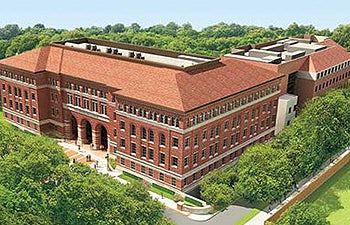Coloring Outside the Lines
For Dr. Gary K. Michelson, the USC Michelson Center for Convergent Bioscience, made possible after his and his wife Alya’s $50 million donation, has never been about a name on a building.
“I never named anything after myself, there’s no Michelson anything,” said the retired orthopedic spinal surgeon and inventor of hundreds of instruments, implants and procedures that make spinal surgeries faster and safer.
“For me, it’s all about the science,” said Michelson, who holds, or has pending, nearly 1,000 patents worldwide.
Michelson cares deeply about his causes, beginning with his desire to study orthopedic surgery.
His mother was about 20 when she gave birth to Michelson, who has three brothers. Growing up in Philadelphia, he was close to his grandmother, a former tennis champion, who lived near his grade school. He often went to his grandma’s for lunch and would see her in pain.
“My grandmother was still a young woman, but she couldn’t stand up straight,” Michelson said. “She was in constant back pain, all the muscles were gone out of her hands so her hands were like garden tools.”
Her crippling spinal deformity made an indelible imprint on a young Michelson, sparking his belief in research that improves lives.
After spending 35 years devoted to improving the lives of those with spinal problems, Michelson retired from private practice in 2001. He turned much of his attention to building foundations for causes such as animal welfare, textbooks and medical research.

The 190,000-square-foot USC Michelson Center will stand in the southwest quadrant of the University Park campus, home to most of the science and engineering buildings.
Michelson recalled receiving the call from USC about a possible collaboration.
“This was the first time anyone had approached me about convergent bioscience,” said Michelson, who grew intrigued by the proposal.
He recalled the initial meeting with Dean Steve Kay, Provost Professor of Biological Sciences and Biomedical Engineering Scott Fraser, and Executive Vice Provost Michael Quick. All three professors are scientists.
“All we talked about for an hour was science,” Michelson recalled. “In particular, I thought USC presented a visionary, daringly bold overarching architecture for how to conduct science at a university.”
A longtime philanthropist for research at universities, Michelson noted that “most universities take pride in the fact that they’re ivory towers and do ‘heads down’ research, research for research’s sake.”
“And this sure wasn’t that,” he said. “This was the idea of doing convergent research to produce real-world breakthroughs in real time.”
The Michelson Center will be the cornerstone of a new collaboration between USC Dornsife and the USC Viterbi School of Engineering meant to transform how research is conducted at the intersection of engineering and the life and biomedical sciences.
“You need to do science for some greater purpose, for humanity’s sake,” said Michelson, a devoted family man. He and his Russian-born wife Alya, an artist and musician who speaks four languages, including Japanese, have two children, Sasha and Isaiah.
As he spoke in the couple’s West Los Angeles home, the conversation ranged from the ever-shrinking subsections of scientific specialties to Eric Lander, a mathematician who made one of the most important contributions to the unrelated field of genetics: the Human Genome Project. Michelson also brought up one of his favorite books, All I Really Need to Know I Learned in Kindergarten.
“When the kid gives the parents his coloring book and the parents say, ‘Oh, that’s beautiful, but I don’t think the sky is purple and you must keep the crayons inside the lines, the parents may mean well, but that’s a very damaging response,” he said.
“Coloring outside the lines is the beginning of thinking outside the box.”
Read more about Convergent Bioscience at USC Dornsife
Read more stories from USC Dornsife Magazine‘s Spring-Summer 2014 issue